 A necklace is an article of jewellery which is worn around the neck. Necklaces are frequently formed from a metal jewellery chain. Others are woven or manufactured from cloth using string or twine. Necklaces have been an integral part of jewelry since the time of ancient civilizations and pre-date the invention of writing.
A necklace is an article of jewellery which is worn around the neck. Necklaces are frequently formed from a metal jewellery chain. Others are woven or manufactured from cloth using string or twine. Necklaces have been an integral part of jewelry since the time of ancient civilizations and pre-date the invention of writing.The oldest necklaces were made of purely natural materials - before weaving and the invention of string, durable vines or pieces of animal sinew left over from hunts were tied together and adorned with shells, bones or teeth or colourful skins of human prey animals, bird feathers, corals, carved pieces of wood, colorful seeds or stones or naturally occurring gems, or other beautiful or artful natural elements found nearby.
Jewellery had great status with India’s royalty; it was so powerful that they established laws, limiting wearing of jewellery to royalty. Only royalty and a few others to whom they granted permission could wear gold ornaments on their feet. This would normally be considered breaking the appreciation of the sacred metals. As the empire matured, differing styles of ornament acquired the generic name of sarpech, from sar or sir, meaning head, and pech, meaning fastener.
Most modern commercial jewellery continues traditional forms and styles, but designers such as Georg Jensen have widened the concept of wearable art. The advent of new materials, such as plastics, Precious Metal Clay (PMC), and colouring techniques, has led to increased variety in styles.
Other advances, such as the development of improved pearl harvesting by people such as Mikimoto Kōkichi and the development of improved quality artificial gemstones such as moissanite (a diamond simulant), has placed jewellery within the economic grasp of a much larger segment of the population.